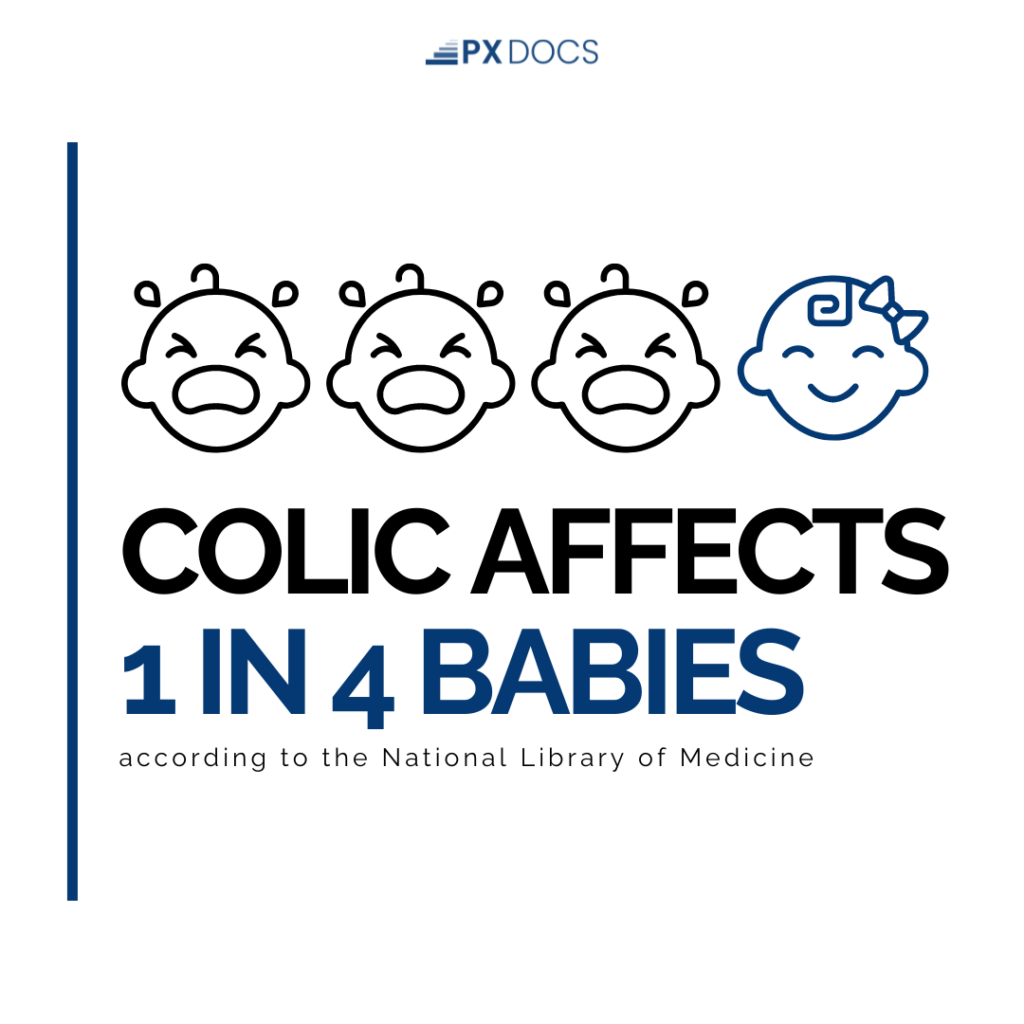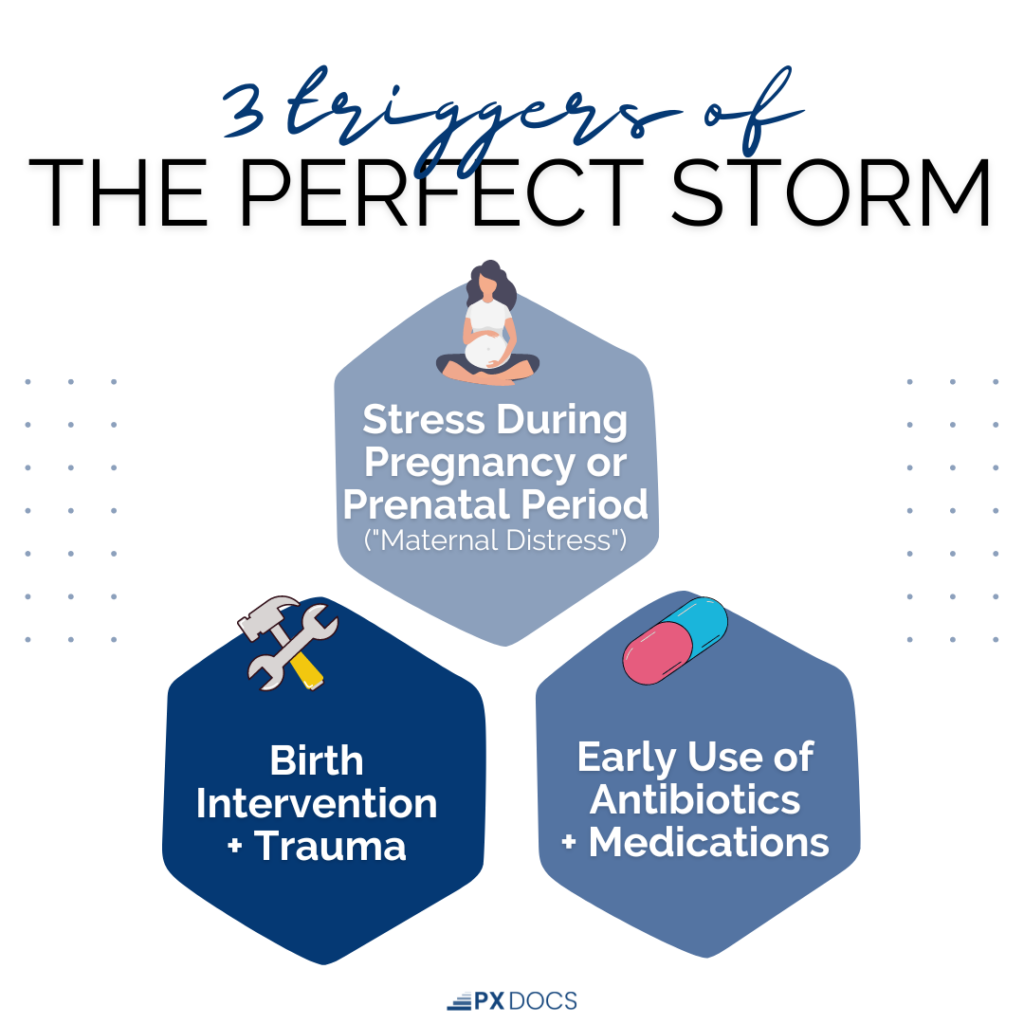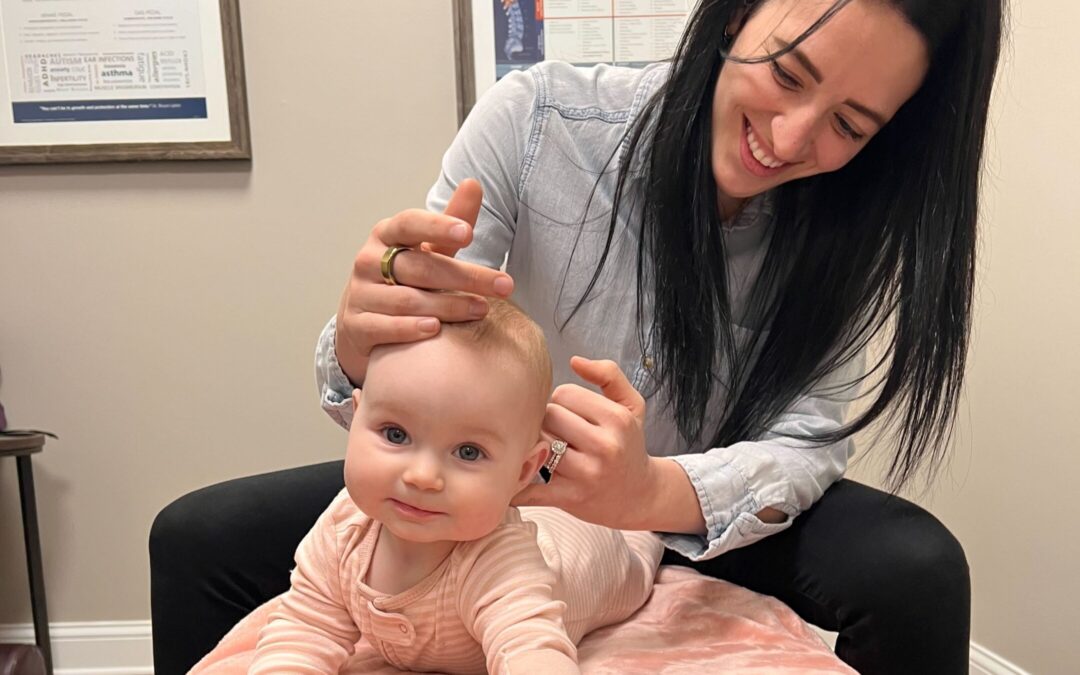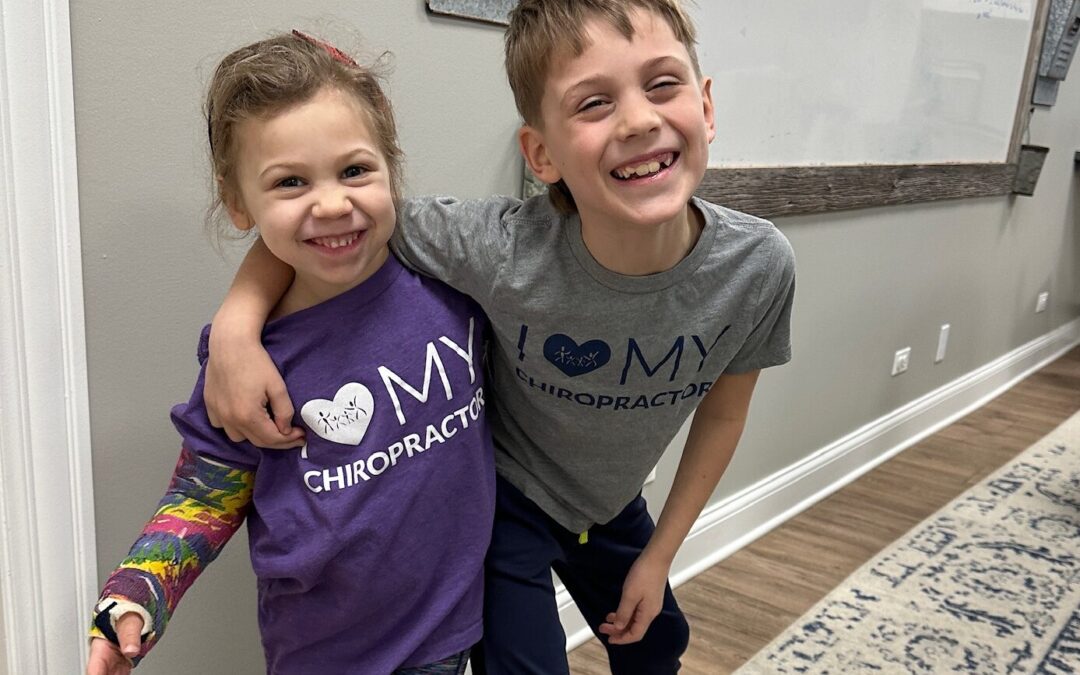Caring for a crying baby is something parents are naturally wired to do, making sure they are well-fed, changed, and soothed. But when intense crying persists for hours a day without consoling, leaving both baby and parents exhausted, it becomes concerning.
This all-too-common infant health challenge has a name – infantile colic.
Colic affects 1 in 4 babies in the first three months of life and actually has a fair amount of controversy to it as well that we’ll go through later on. If your baby has prolonged crying fits over 3 hours a day, at least three days a week, they likely have colic.

Despite colic’s prevalence, conventional medicine claims its causes “remain a mystery” and suggests just waiting it out. This leaves caring parents feeling dismissed and hopeless.
However, emerging evidence reveals colic is not simply normal crying infants will simply outgrow, but rather a signal of neurological dysfunction requiring support. When providers really dig deep with parents to help them get to the root cause of their child’s colic, it can then be addressed naturally and without drugs. This brings relief not just to your little one but to the whole family.
Colic is more than normal fussiness that a child outgrows; it often indicates an imbalance and disruption of optimal neurological and digestive function. If left unresolved, this can lead to the child developing other health challenges later in life, such as constipation, respiratory and immune issues, sensory processing disorder, and more.
By addressing the real root causes, Neurologically-Focused Chiropractic Care applied early in life can improve the function of both the nervous system and digestion, prevent long-term issues colic often leads to, and help families thrive.
This article explains the true root causes of colic and introduces a drug-free approach – Neurologically-Focused Chiropractic Care, that helps to calm colic by restoring neurological function and digestive motility.
What Is Colic?
Colic involves intense, extended, and inconsolable crying in otherwise healthy infants. More specifically, experts define colic as crying that:
- Lasts over 3 hours per day
- Occurs more than three days per week
- Persists over three weeks
- Resists soothing
Colicky cries sound more urgent than typical hunger or wet diaper cries. These babies often clench their fists, arch their backs, and bear down, suggesting intestinal discomfort.
The arching and stiffening of the neurospinal system is often a strong indication of exactly where the root cause of tension and dysfunction are coming from – subluxation and neurological dysfunction that may have been originally triggered by in-utero constraint or physical injury via birth intervention and trauma.
Colic Symptoms
Colic has distinct symptoms, setting it apart from normal crying. Colicky babies tend to have intense, prolonged crying bouts exceeding 3 hours a day for over three days a week. Their distress peaks in the late afternoon and evening when parents are exhausted themselves. Other signs accompanying the excessive crying include:
- High-pitched, urgent cries vs. general discomfort cries
- Clenched fists and tensed muscles
- Arching the back and neck
- Drawing legs up towards the abdomen
- Facial flushing or skin discoloration
- Passing gas or abdominal rumbling
- Resisting soothing techniques
What is a Colic Baby?
A colicky baby is one who experiences frequent intense crying bouts that last for extended periods of time, with no apparent cause. These outbursts typically begin suddenly around 2-4 weeks of age and reach their peak around 6 weeks.
While colic itself isn’t dangerous, the nonstop crying significantly disrupts sleep, feeding, digestion, and comfort for both baby and parents. Yet despite impacting as many as 30% of babies between two weeks and four months, conventional medicine lacks explanations and effective solutions beyond waiting it out.
What Causes Colic?
Colic, contrary to common belief, is not solely caused by digestive issues like gas or food sensitivities. Instead, it is commonly triggered by neurological dysfunction and interference that can impair not just digestive function but other important bodily functions as well, leaving the child uncomfortable.
When this tension and dysfunction build up within the neuromuscular system, which is known as subluxation, it can disrupt communication between the brain and organs such as the gut.
In most cases, helping parents find the real root cause of colic can actually be a fairly simple process. That is because, by the time most parents seek out Neurologically-Focused Chiropractic Care to help, they’ve already gone through a whole host of diet changes and restrictions, probiotics and other supplements, gripe water, essential oils, and other natural treatments that target the gut and digestive system.
If a family has already done all they can to support the child’s gut nutritionally, it almost certainly leaves what we refer to as neurogenic colic as the real root cause of the discomfort. This means that the tension and subluxation originate from within the nervous system first.
The resulting neurological dysfunction creates a “neuro-storm” of signals that disrupt sleep, digestive function, and so much more. A colicky baby’s system then constantly cries, moves, twists, and torques to try and find calm and regulation amidst that storm of stress and tension.
Learning more about nervous system regulation is something that helps families find vastly improved health and well-being, even for their littlest ones, like an infant struggling with colic.
The Impact of Colic
The relentless cries of colic can have consequences beyond temporary discomfort, disrupting overall development and family wellness. Appreciating these long-term impacts underscores the importance of natural solutions that seek to address the root cause of colic and help the child and entire family find relief.
For babies, persistent distress and lost sleep hinder physiological regulation, sensory integration, and overall growth and development. These early life neurophysiological disruptions now cascade into challenges with self-soothing, behavior, relating, and learning down the road. The vast majority of patients we see in our clinic who struggle with sensory, spectrum, and behavior challenges later in life have infantile colic in their case history.
The obstacles colic presents also disrupt breastfeeding, interfere with optimal bonding during a sensitive period, and bring formula risks. Fathers, siblings, and marriages also suffer as sleep for the whole family is interrupted, exhaustion sets in, work is disrupted, and so forth.
In severe cases, colic’s burden predisposes caregivers to shaken baby syndrome or postpartum depression. Even milder courses deserve access to solutions, easing unnecessary suffering for everyone involved.
Common Misconceptions of Colic
Conventional medicine offers explanations like digestive upset from gas or food sensitivities. However, these do not fully account for colic’s distress, and solutions targeting them alone often come up short.
For instance, some suggest colicky babies swallow more air, crying, causing gas pain. However, colicky babies don’t produce more gas than typical infants. While probiotics, formula changes, and anti-gas drops might provide minor relief, they don’t fully resolve colic.
Additionally, some research and many natural health forums suggest that allergies to cow’s milk, lactose intolerance, or other food intolerances cause crying bouts in babies. However, research shows that formula intolerances are rare, and eliminating dairy from nursing mothers’ diets is largely ineffective in reducing crying time.
More misconceptions around colic include:
- It is normal to cry, and babies will just “grow out of it.”
- Colic is caused by digestive upset like gas pains or food sensitivities alone.
- Formula changes or probiotics can fully cure colic.
- Eliminating dairy from a nursing mother’s diet will fully resolve colic.
- Colicky babies just have more gas and need to pass it.
- There’s nothing parents can do besides wait it out and “let the baby cry.”
- Excessive crying won’t cause any long-term issues.
- Colic happens randomly in some babies and can’t be prevented.
In reality, digestive factors and food intolerances absolutely play a role. But first, we need to ask the deeper question – why are the digestive problems and food intolerances there in the first place?
For most infants, the gut issues result from more disruption and dysfunction of the nervous system, often triggered by an overly stressful pregnancy or physically traumatic birth intervention.
One additional very important element we need to bring into the conversation here is something called tongue and lip ties, otherwise known as TOTs or “Tethered Oral Tissues,” which have exploded in the amount of recognition and treatment (most commonly a laser frenectomy correction) in the last few years. These ties are something that can definitely cause issues with latching, swallowing, digestion, and breathing for your little one, but just like with digestive issues, the real foundational question needs to be – why are they there in the first place?
Whenever the sympathetic nervous system is overstimulated and “stuck on” from a neurological perspective, that then sets and dictates the tone for all other tissues, organs, and glands, including then the tongue and lip ties. If the subluxation and excessive sympathetic dominant tone is not first addressed, then most commonly, the child will still struggle (and sometimes more) after the laser correction is done. For more information on tongue ties and their role in all this, please check out this article here.
The Colic “Perfect Storm”

To fully understand colic’s neurological basis, we must introduce an important concept called the “Perfect Storm.” This refers to a sequence of stressors disrupting healthy development.
It begins with maternal emotional trauma, inflammation, or chronic distress during pregnancy, which can shift both mom and baby’s developing nervous system into a sustained sympathetic fight or flight response. Other research points to the likelihood that excessive maternal stress doesn’t just trigger a sympathetic response but may interfere with the development of the vagus nerve and autonomic nervous system altogether.
Then, birth interventions like forceps, vacuum extraction, c-section, and induction can create physical tension and constraint that leads to subluxation in the upper neck, upper back, and mid-spinal regions, which house and protect the delicate nerves that control latching, swallowing, sleeping, soothing, and digestive motility.
When it comes to colic, more parents deserve to know about the role subluxation, vagus nerve dysfunction, and dysautonomia all play in triggering the symptoms of colic. For most families, these neurological elements still fly under the radar and are simply not communicated as a potential cause for colic and other common pediatric conditions.
At PX Docs, it’s our mission to get the word out about the real root cause of these things, always starting with nervous system dysfunction first and foremost. Then, once a child’s nervous system function and homeostasis is restored, if problems still persist, we can help guide the family through proper diet changes, probiotic supplementation, and so forth. However, in most cases, children struggling with colic experience so much improvement with chiropractic alone that other interventions are often not needed.
There are Answers: Neurologically-Focused Chiropractic Care
Whereas traditional medicine overlooks the foundational role the nervous system plays and seeks to just suppress symptoms, Neurologically-Focused Chiropractic Care goes right to the real root cause.
Our PX Docs Network specializes in finding and identifying these areas of subluxation and neurological dysfunction in infants, using both a gentle physical exam and an advanced neuro-scanning technology called the INSiGHT Scans that further pinpoints and helps quantify the neurological stress patterns often associated with colic.
From there, we’re able to then gently adjust and clear the subluxations and tension that are causing the child to be uncomfortable, and so often, you see the infant immediately relax, unwind, and often fall asleep.
In addition to countless cases of positive changes our PX Doctors have seen throughout their clinical practices, many research studies like those linked below have demonstrated how much chiropractic care can help these struggling families and stressed-out little ones!
Parents, there is Hope, Answers, and Drug-Free Help for colic, and it’s just a click or two away! Head over to our PX Docs Directory here to schedule your consult and exam today.





